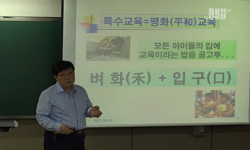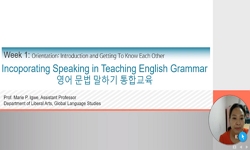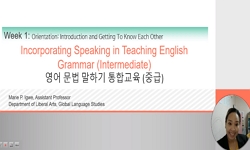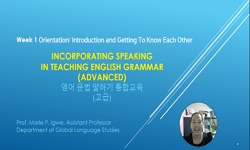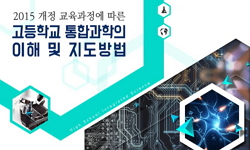이 연구는 제도적으로 마련된 통합교육 환경에서 유아들이 스스로 구성하는 통합이 무엇인지에 대한 궁금증으로부터 시작되었다. 그리고 이 질문은 장애유아와 일반유아의 상호작용에 대...
http://chineseinput.net/에서 pinyin(병음)방식으로 중국어를 변환할 수 있습니다.
변환된 중국어를 복사하여 사용하시면 됩니다.
- 中文 을 입력하시려면 zhongwen을 입력하시고 space를누르시면됩니다.
- 北京 을 입력하시려면 beijing을 입력하시고 space를 누르시면 됩니다.
통합학급 장애유아와 일반유아의 상호작용에 대한 질적 연구 = (A) qualitative research on interactions between disabled and non-disabled preschoolers in the inclusive classroom
한글로보기https://www.riss.kr/link?id=T10501754
- 저자
-
발행사항
서울 : 서울여자대학교 대학원, 2006
-
학위논문사항
학위논문(박사) -- 서울여자대학교 대학원 , 아동학과 , 2006. 2
-
발행연도
2006
-
작성언어
한국어
- 주제어
-
KDC
598.123 판사항(4)
-
DDC
649.123 판사항(21)
-
발행국(도시)
서울
-
형태사항
ix, 288p. : 삽도 ; 26cm
-
일반주기명
참고문헌: p. 275-283
- 소장기관
-
0
상세조회 -
0
다운로드
부가정보
국문 초록 (Abstract)
이 연구는 제도적으로 마련된 통합교육 환경에서 유아들이 스스로 구성하는 통합이 무엇인지에 대한 궁금증으로부터 시작되었다. 그리고 이 질문은 장애유아와 일반유아의 상호작용에 대한 관심으로 이어졌다. 이 연구에서 다룬 내용은 장애유아와 일반유아의 상호작용이 어떻게 변화하는가, 그와 관련된 변수는 무엇인가이다. 그리고 이것이 통합유아교육과 일반유아교육에 시사하는 바가 무엇인가이다. 이를 위해 장애통합교육을 실시하고 있는 경기도 소재의 한 어린이집을 선정하여 2004년 3월부터 2005년 6월까지 참여관찰과 심층면담을 실시하였다. 이 연구는 크게 세 가지 연구문제에 대한 답으로 이루어져 있다. 세 연구문제를 중심으로 발견한 것들을 제시하면 다음과 같다.
첫째로, 장애유아와 일반유아는 상호작용을 통해 어떻게 변화하는지 살펴보았다. 그 결과 장애유아는 일반유아와 상호작용을 통해 점차 ‘교육적 가능성’의 세계로 나아간다. 장애유아는 일반유아를 끊임없이 본다. 장애유아는 이와 같은 보기를 통해 ‘하고 싶다’는 욕망을 느낀다. 이것은 단지 욕망으로만 그치지 않고 실행하기를 통해 능력과 결부된다. 그런데 장애유아가 욕망을 실현해내는 데에는 개인차가 있다. 장애유아는 장애 유형과 정도에 따라 각기 다른 변화 속도로 능력을 키워나간다. 한편, 일반유아는 장애유아와 상호작용을 통해 장애인식의 변화를 보인다. 구체적으로 일반유아의 장애인식은 크게 다음 세 단계로 변화한다.
(1) 일반유아는 장애유아를 ‘우리와 다르다’고 인식한다. 이때 일반유아는 ‘못하는 것이 많아서 장애인’이라고 구별짓다가 점차 ‘장애인이라서 못한다’고 인식한다. 이와 같은 인식은 장애유아를 차별하는 행동반응으로 이어지기도 한다. 그리고 장애유아는 ‘더러운 아이’, ‘침 흘리는 아이’, ‘소리 지르는 아이’ 등과 같이 장애특성에 따라 달리 불려진다.
(2) 일반유아는 장애유아를 ‘우리와 다르지만 같다’고 인식한다. 이것은 그 전단계보다 더 진보한 것임에도 불구하고, 여전히 ‘능력’을 기준으로 자신과 장애유아를 구분짓는다는 점에서 동일하다. 그리고 장애유아는 ‘귀여운 아이’, ‘재미있는 아이’, ‘코코코코’ 등으로 불려진다. 그런데 이것은 일반유아가 전 단계에서 부정적으로 보았던 장애특성을 장점으로 보고 다르게 부르는 것이다.
(3) 일반유아의 장애인식이 ‘우리는 모두 다르다’에 이르면, 더 이상 ‘능력’을 기준으로 장애유아를 구별해내지 않게 된다. 이때 일반유아는 자신과 다른 장애유아의 ‘차이’를 근거로 차별하지 않고 ‘다양성’으로 받아들인다. 그리고 장애유아는 ‘귀여운 성주’, ‘웃는 게 예쁜 예지’, ‘재미있는 찬수’ 등과 같이 고유한 이름으로 불려진다.
이 세 가지 장애인식은 전반적인 발달 양상이다. 더 세분화시켜 세 가지 집단유형으로 분류할 수 있다. 이것은 ‘경계하거나 무시하는 아이들’, ‘무시도 하고 도움도 주는 아이들’, 그리고 ‘배려하는 아이들’ 집단으로, 장애인식 변화에 따라 발달해 간다. 그러나 모든 일반유아가 이와 같은 장애인식에 다 도달하는 것은 아니다. 그 변화 속도에는 개인차가 있다.
둘째로, 장애유아와 일반유아의 상호작용 변화에 관련된 변수는 무엇인가 살펴보았다. 이를 위해 관계별, 교사별, 그리고 부모별 변수로 나누었다. 먼저, 관계별 변수가 있다. 여기에는 관계망 형성과 호혜적 교환이 있다. 관계망 형성은 양방 이상의 상호작용에 작용하는 중요한 변수다. 또한 호혜적 교환은 일반유아와 장애유아가 지속적으로 돌봄을 주고받는 것과 관련이 있다. 다음으로, 교사별 변수가 있다. 여기에는 전반적 개입과 유형별 개입이 있다. 교사의 개입전략은 대상에 따라 차이가 있지만 일상 속에서 ‘스며들듯이’ 자연스럽게 이루어진다. 특히, 교사는 체험과 성찰을 통해 장애통합학급 교사로서의 정체성을 형성해나간다. 마지막으로, 부모별 변수가 있다. 특히, 부모 자신이 직접 몸을 통해 보여주는 실천은 일반유아의 장애유아 배려와 관련이 있다.
셋째로, 위 결과들이 장애통합교육에 주는 시사점은 무엇인가 살펴보았다. 그 결과를 다음 두 차원으로 제시할 수 있다. 먼저, 통합유아교육에 대한 시사점은 ‘몸을 통한 의미 공유’와 ‘욕망의 중층성과 탈중심화’이다. 음성언어로 타자와 소통하기 어려운 장애유아에게 몸짓언어는 중요한 소통수단이다. 몸은 통합학급 유아들의 상호작용 질서의 가장 기본적인 단위이자 중심임을 알 수 있다. 또한 욕망은 장애유아가 점차 더 나은 능력을 갖게 한다. 여기에서 능력은 가능성이지 종결된 상태나 성과가 아니다. 중요한 것은 개인마다 능력이 발휘될 수 있는 상황, 조건, 맥락이 다르다는 것이다. 이것은 일반유아의 ‘정상성’을 중심에 놓고 장애유아의 능력을 평가하는 것에서 벗어날 것을 요구한다. 다음으로, 일반유아교육에 주는 시사점은 장애인식 전환교육과 ‘장애사회화’가 아닌 ‘장애교육’ 두 가지가 있다. 일반유아는 장애유아의 동일한 특성을 장애인식에 따라 다르게 본다. 따라서 장애인식 전환의 중요성과 이를 위한 교육적 노력이 요구됨을 알 수 있다. 특히, 일반유아의 장애인식은 ‘장애유아의 얼굴보기’와 ‘장애유아 되기’와 같은 존재론적 만남을 계기로 전환되는 것을 볼 수 있다.
기존의 장애통합과 관련된 연구들은 주로 통합의 당사자인 장애유아와 일반유아에게 통합이 어떤 의미인지에 대한 관심을 상대적으로 많이 기울이지 않았다. 그러나 이 연구는 제도적으로 마련된 통합 환경 속에서 장애유아와 일반유아가 상징적 상호작용 속에서 구성해내는 통합이 무엇을 의미하며, 구체적으로 어떻게 전개되는지 그 역동적인 과정을 풍부하게 드러내는 데 기여할 수 있다고 생각한다.
다국어 초록 (Multilingual Abstract)
This study started out as an attempt to find out what kind of inclusion is formed by preschool children themselves in inclusive classroom settings by examining the interactions between disabled and non-disabled preschool children. The purpose of the s...
This study started out as an attempt to find out what kind of inclusion is formed by preschool children themselves in inclusive classroom settings by examining the interactions between disabled and non-disabled preschool children. The purpose of the study was to understand how the interactions between disabled and non-disabled children change, what factors are involved, and what the findings imply for inclusive and mainstream preschool education. For this purpose, I chose one day care center in Kyung-gi province that offers inclusive education, and conducted participant observation and in-depth interview there from March 2004 through June 2005. This study presents answers to the above-mentioned three questions addressing the objective of the study.
First, disabled children were exposed to greater educational possibilities through interactions with non-disabled children. On the other hand, non-disabled children exhibit changes in their perception of disability through interactions with disabled children. More specifically, preschool children's concepts of disability in their peers have changed through the following three stages:
(1) Initially, non-disabled children had an awareness that disabled children are ‘different’ from themselves. At first, non-disabled children recognize apeer as disabled ‘because he or she is unable to do things.’ The perception changes gradually to the extent that non-disabled children think their peer is unable ‘because he or she is a person with disability.’
(2) Non-disabled children view their disabled peers as ‘different in someways, but ultimately the same.’ Although this level of awareness is much more advanced, it is basically the same as the previous one in that non-disabled children continue to use the concept of ‘ability’ as their criteria for discerning themselves from disabled peers.
(3) When non-disabled children's perception of disability reaches the level of awareness that ‘everyone is different,’ they no longer use the concept of ‘ability’ for discerning disabled peers. At this stage, non-disabled children no longer discriminate against disabled children based on their ‘difference’, but rather, accept the difference as stemming from ‘diversity.’
In general, most children undergo these three development stages. More specifically, they can be grouped into three categories: those who are wary of or have a disregard for disabled peers; those who disregard disable peers while helping them out; and those who actively take care of their disabled peers. Still, not all children go through the same development stages. The speed and degree of change in perception varies depending on the individual.
Second, it was found that the factors that affect the changes in interaction between disabled and non-disabled preschoolers are relationships, instructors' intervention, and parents' intervention. Relationship factors include relationship building and reciprocal exchange: the former is an important factor that has an influence on interaction between more than two parties; the latter is related to continuous exchange of attention and care between disabled and non-disabled children. Instructors' intervention comes in two categories: comprehensive intervention and individualized intervention. Instructors' intervention strategies may vary depending on the child. But, the main principle is that intervention should be implemented naturally as part of everyday activities. On the part of the instructor, in particular, her identity as a teacher for an inclusive class is established through a series of firsthand experience and introspection. Lastly, parents' behavior is closely related to the degree of attention and care of non-disabled children toward disabled.
Third, these findings revealed useful implications for both inclusive and mainstream education in preschool. For inclusive education, the findings of the study highlight the importance of ‘communication through body’ and ‘multiplication of desire and decentralization.’ For understanding impaired children, body language is an important means of communication. It is evident that body is the center as well as the most basic unit in the order of interaction among preschool children in inclusive classrooms. Desire, on the other hand, drives disabled children to develop their ability further. Here, ‘ability’ is an open possibility, rather than a finite end or achievement. It should be noted that each individual child requires different settings, conditions, and context for fully performing their ability. Therefore, the ability of a disabled child should not be assessed against the ‘normality’ of non-disabled children. The implication for mainstream preschool education is that efforts should be made to change children's perception of disability and conduct ‘inclusive education’, instead of ‘socialization of disability.’ Non-disabled children may see their similarities with their disabled peers, but still consider them as different due to their perception of disability. This is why it is important to make efforts to change their perception of disability. Ontological encounters through activities like ‘examining the face of a disabled peer’ and ‘becoming the disabled’ are found to be very effective in changing non-disabled children's perception of disability.
Existing literature on inclusion of disability has paid relatively less attention to the significance of inclusion for the ‘included’ children themselves. By contrast, this study focused on the inclusion constructed through symbolic interactions between disabled and non-disabled children under the inclusive circumstances, and how it is played out in its most dynamic process.
목차 (Table of Contents)
- 논문개요 = ⅰ
- 목차 = ⅴ
- Ⅰ. 서론 = 1
- 1. 연구의 동기 = 1
- 2. 연구의 필요성과 목적 = 3
- 논문개요 = ⅰ
- 목차 = ⅴ
- Ⅰ. 서론 = 1
- 1. 연구의 동기 = 1
- 2. 연구의 필요성과 목적 = 3
- 3. 연구문제 = 10
- 4. 연구의 범위와 한계 = 12
- Ⅱ. 이론적 배경 = 14
- 1. 장애유아 통합교육 = 14
- 1) 주제별 개관 = 15
- 2) 방법별 개관 = 19
- 2. 장애유아와 일반유아의 상호작용 = 21
- 1) 주제별 개관 = 22
- 2) 방법별 개관 = 30
- 3. 상징적 상호작용론 = 32
- 1) 기본 개념 = 32
- 2) 연구 도구로서의 적용 = 40
- Ⅲ. 연구대상과 연구방법 = 45
- 1. 연구대상 : '푸른어린이집'의 '하늘반'과 '은하반' = 45
- 1) 장애통합지정기관인 '푸른어린이집'의 특성 = 46
- 2) '푸른어린이집'의 환경과 운영체제 = 48
- 2. 연구방법 = 54
- 1) 참여관찰과 심층면담 = 54
- 2) 자료 수집과 분석 = 56
- 3) 연구참여자 소개 = 58
- 3. 참여관찰 초기의 통합학급 상황 = 61
- 1) 일반유아의 장애인식 : 다름을 알고 거리두기 = 64
- 2) 세 장애유아의 차이점 = 68
- (1) 하고 싶은 대로 하는 찬수 : "또 밖에 나가요" = 69
- (2) 주변을 맴도는 지수 : "조금 잘해요" = 71
- (3) 두려움이 많은 예지 : "자꾸 때려요" = 72
- 3) 초기 상호작용의 양상 = 75
- (1) 시작은 일반유아가, 지속은 장애유아가 = 75
- (2) 온몸으로 말하고 듣기 = 77
- Ⅳ. 통합학급 상호작용의 변화 과정 = 80
- 1. 장애유아의 변화 = 80
- 1) 전반적 변화 = 80
- (1) 보기의 지표들 = 81
- (2) 보기의 단계별 의미: "하고 싶다"에서 "하자"로 = 83
- (3) 전반적 변화의 양상 = 86
- 2) 장애유형별 변화 = 92
- (1) 자폐적 성향의 발달장애아 : '찬수'와 '예지' = 93
- (2) 자폐적 성향이 없는 발달장애아 : '지수' = 100
- (3) 자폐적 성향이 없는 신체장애아 : '성주'와 '호수' = 105
- 2. 일반유아의 변화 = 112
- 1) 전반적 변화 = 113
- (1) 우리와 다르다 : "우리 친구면 하는데요. 우리 친구가 아니에요." = 113
- (2) 우리와 다르지만 같다 : "우리하고 같이 할 수 있어요." = 124
- (3) 우리는 모두 다르다 : "우리는 잘하는 것도 못하는 것도 있어." = 135
- 2) 집단유형별 변화 = 141
- (1) 경계하거나 무시하는 아이들 = 142
- (2) 무시도 하고 도움도 주는 아이들 = 147
- (3) 배려하는 아이들 = 153
- Ⅴ. 통합학급 상호작용의 관련 변수 = 163
- 1. 관계별 변수 = 163
- 1) 관계망 형성 = 163
- (1) 장애아를 배려하는 세력아 = 164
- (2) 장애아를 경계하는 세력아 = 166
- 2) 호혜적 교환 = 169
- (1) 일반유아의 놀아주기와 장애유아의 추종하기 = 169
- (2) 일반유아의 장애유아 돌보기와 타자의 인정 = 172
- (3) 장애유아에게 허용된 면책권에 편승 = 178
- 2. 교사별 변수 = 183
- 1) 전반적인 접근 방식 = 186
- (1) 장애유아에 대한 접근 = 186
- (2) 일반유아에 대한 접근 = 192
- 2) 유형별 접근 방식 = 198
- (1) '사오정인 미숙한 해석가' = 198
- (2) '숙련된 통역가인 전달자' = 200
- (3) '역경의 안내자' = 205
- 3) 교사의 체험과 성찰 = 209
- 3. 부모별 변수 = 215
- 1) 장애유아의 부모 = 215
- (1) 일반유아에게 다가가기 : "엄마하기 나름이예요" = 217
- (2) 자녀의 변화 : "하고 싶은 게 많아졌어요." = 220
- 2) 일반유아의 부모 = 224
- (1) 장애유아에게 다가가기 : '말'보다 '실천'을 통해 보여주기 = 224
- (2) 자녀의 변화 = 230
- Ⅵ. 해석 및 논의 = 235
- 1. 통합유아교육에 주는 시사점 = 235
- 1) 몸을 통한 의미 공유 = 236
- 2) 욕망의 중층성과 탈중심화 = 241
- 2. 일반교육에 주는 시사점 = 247
- 1) 장애인식 전환교육 = 247
- 2) 장애사회화와 장애교육 = 252
- Ⅶ. 요약 및 결론 = 259
- 1. 요약 = 259
- 2. 결론 = 267
- 참고문헌 = 275
- Abstract = 285





